
bain_report_private_equity_report_20
.pdf
vk.com/id446425943
Global Private Equity Report 2019
• • •
Advanced analytics: Delivering quicker and better insights
At a time when PE firms face soaring asset prices and heavy competition for deals, advanced analytics can help them derive the kinds of proprietary insights that give them an essential edge against rivals. These emerging technologies can offer fund managers rapid access to deep information about a target company and its competitive position, significantly improving the firm’s ability to assess opportunities and threats. That improves the firm’s confidence in bidding aggressively for companies it believes in—or walking away from a target with underlying issues.
At a time when PE firms face soaring asset prices and heavy competition for deals, advanced analytics can help them gain an essential edge against rivals.
What’s clear, however, is that advanced analytics isn’t for novices. Funds need help in taking advantage of these powerful new tools. The technology is evolving rapidly, and steady innovation creates a perplexing array of options. Using analytics to full advantage requires staying on top of emerging trends, building relationships with the right vendors, and knowing when it makes sense to unleash teams of data scientists, coders and statisticians on a given problem. Bain works with leading PE firms to sort through these issues, evaluate opportunities and build effective solutions. We see firms taking advantage of analytics in several key areas.
Scraping the web 2.0
Many PE funds already use scraping tools to extract and analyze data from the web. Often, the goal is to evaluate customer sentiment or to obtain competitive data on product pricing or assortment. New tools make it possible to scrape the web much more efficiently, while gaining significantly deeper insights. Deployed properly, they can also give GPs the option to build proprietary databases over time by gathering information daily, weekly or at other intervals.
Using a programming language such as Python, data scientists can direct web robots to search for and extract specific data much more quickly than in the past (see Figure 2.17). When one global PE fund was evaluating a delivery service company, for instance, it needed to create a list of all the stores the service worked with to estimate its market penetration. Traditional web scraping would have required several days. But the new technology produced a complete list of stores in a few hours. The same quick results helped another PE fund evaluate a wellness chain. Overnight, data scientists com-
67
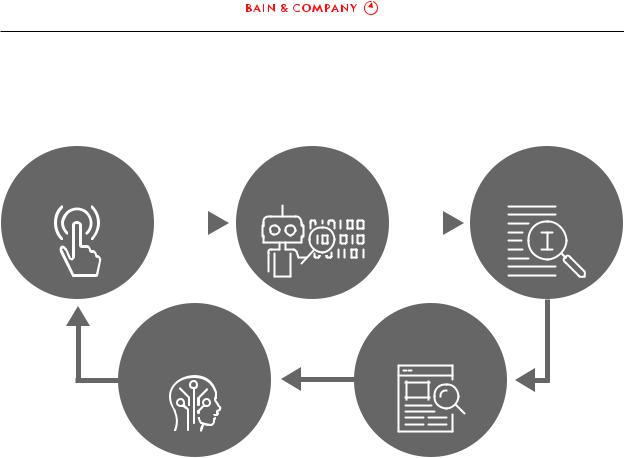
vk.com/id446425943
Global Private Equity Report 2019
Figure 2.17: Web scraping 2..0 uses programming language to produce more powerful insights, faster
Identify |
|
Use code |
|
Run program |
target websites |
|
to guide robots |
|
and extract raw data |
|
|
|
|
|
|
|
|
|
|
Do this over |
Generate and |
and over to build |
visualize insights |
proprietary knowledge |
|
Source: Bain & Company
piled reviews and scores available on the web for the company and all of its competitors. That data allowed the firm to understand the target’s market penetration by location and compare customer scores, including negative and positive comments. With the right code and the right set of target websites, new tools can also allow firms to assemble proprietary databases of historical information on pricing, assortment, geographic footprint, employee count or organizational structure. Analytics tools can access and extract visible and hidden data (metadata) as frequently as fund managers find useful.
Taking a digital X-ray
Most target companies these days sell through online channels and rely heavily on digital marketing. Fewer do it well. The challenge for GPs during due diligence is to understand quickly if a target company could use digital technology more effectively to create new growth opportunities. Post-acquisi- tion, firms often need similar insights to help a portfolio company extract more value from its digital marketing strategy.
Assessing a company’s digital positioning—call it a digital X-ray—is a fast and effective way to gain these insights. For well-trained teams, it requires a few hours to build the assessment, and it can be done from the outside in—before a fund even bids. It is also relatively easy to ask for access to a target company’s Google AdWords and Google Analytics platforms. That can produce a raft of digital metrics and further information on the target’s market position.
68
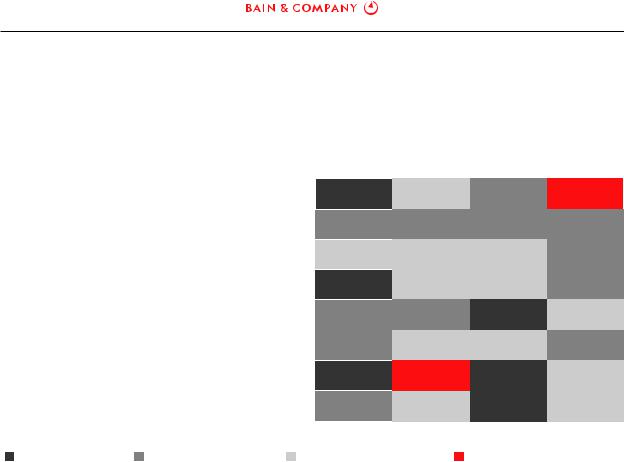
vk.com/id446425943
Global Private Equity Report 2019
Figure 2.18: A digital X-ray showed a PE firm in half a day that its target had little digital marketing upside
Key metrics |
Submetrics |
|
Target |
Competitor |
Competitor |
Competitor |
|||
|
|
|
|
|
|
|
1 |
2 |
3 |
|
|
|
Share of traffic |
|
|
|
|
|
|
|
|
|
|
|
|
|
|
|
|
|
|
|
Source of traffic |
|
|
|
|
|
|
Awareness |
|
|
|
|
|
|
|
|
|
|
|
Paid search performance |
|
|
|
|
|
||
|
|
|
|
|
|
|
|
||
|
|
|
|
|
|
|
|
|
|
|
|
|
Organic search performance |
|
|
|
|
|
|
|
|
|
|
|
|
|
|
|
|
|
|
|
Site performance |
|
|
|
|
|
|
Conversion |
|
|
|
|
|
|
|
|
|
|
|
Conversion rate |
|
|
|
|
|
||
|
|
|
|
|
|
|
|
||
|
|
|
|
|
|
|
|
|
|
|
|
|
Customer engagement |
|
|
|
|
|
|
Brand and |
|
|
|
|
|
|
|
|
|
|
|
|
|
|
|
|
|
|
|
social media |
|
|
Online reviews |
|
|
|
|
|
|
|
|
|
|
|
|
|
|
||
Best-in-class offering |
Few gaps to best in class |
Multiple gaps to best in class |
Significant gaps to best in class |
||||||
Source: Bain & Company |
|
|
|
|
|
|
|
||
Data scientists working for an international PE firm used digital X-ray tools to glean important insights when the firm evaluated a leading online real estate business based in the US. The deal thesis focused on the opportunity to increase revenues significantly by improving traffic to the target’s website. In less than a day, the team tapped multiple data sources to measure the target’s performance using key digital metrics, including awareness, conversion, brand performance and social media effectiveness (see Figure 2.18).
The firm found that the target already ranked as a leader digitally, offering little opportunity to increase web traffic. Although the company had the potential to improve its margin on paid search, there was limited upside there, too; the sector was highly competitive, so absolute margins would still be low. User testing identified something even more troublesome: Customers who visited the target’s website questioned the basic value proposition. The combined insights from the digital X-ray helped convince the PE firm not to make a bid.
Using the power of the masses
One challenge for PE funds historically has been accessing data from large networks or from scattered and remote locations. But new tools let deal teams complete such efforts in a fraction of the time and cost. Take the case of a US portfolio company that believed one of the retail chains carrying its products was not stocking them appropriately, leading many stores to run out of stock. With more
69

vk.com/id446425943
Global Private Equity Report 2019
than 700 store locations nationwide, it would have been time consuming and expensive to send a mystery shopper to visit each store and collect data.
Instead, the company’s management turned to a digital vendor that mobilized a large group of consumers to do the spy work. After registering through a mobile application, the consumers earned small incentives for visiting the retailer’s stores, spending 15 to 20 minutes collecting information and taking photos, and then supplying key data points via the app. In essence, the digital vendor’s program launched an invisible army of mystery shoppers to all of the stores simultaneously. The flood of data confirmed that about 40% of the brand’s products were either out of stock or the store had only one unit left on the shelf (see Figure 2.19). Armed with real data, the portfolio company’s management convinced its retail partner to take immediate action.
Understanding traffic data
One issue that PE deal teams often ponder in evaluating companies is traffic patterns around retail networks, manufacturing facilities and transport hubs. Is traffic rising or declining? What’s the potential to increase it? In some industries, it’s difficult to track such data, especially for competitors. But high-definition satellite images or drones can glean insights from traffic flows over time. Take the case of a global PE investor in the midst of due diligence on a retail target. The target company’s financial performance had improved significantly over the previous five years, but it still lagged its
Figure 2.19: A portfolio company used an invisible army of shoppers to rapidly see where its products were out of stock
Creative way to gather information from scattered locations
Nearly 40% of products out |
Stocking problem consistent across |
of stock or almost depleted |
the country |
1 Mystery shopper program launched via mobile app
2 Users visit stores, collect data and take photos
3 Digital vendor validates results
Source: Bain & Company
20%
Out of stock
18%
Store with stock problems
Only one left on shelf
70
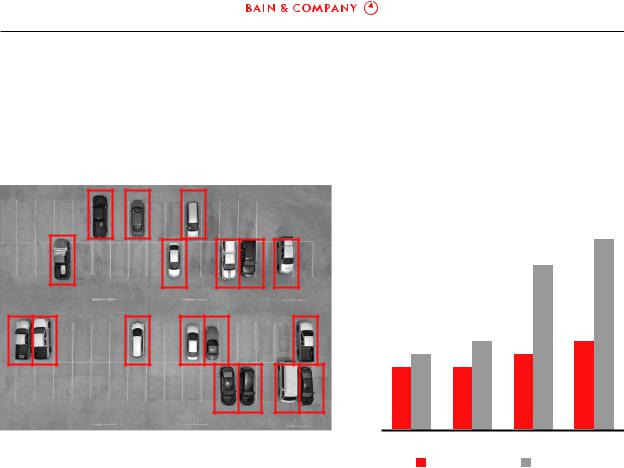
vk.com/id446425943
Global Private Equity Report 2019
Figure 2.20: A PE firm harnessed satellite technology to gain insight into a target’s performance
Satellite images used to analyze daily car counts |
Competitor’s car count grew faster than the target’s |
Growth in car counts (based on normalized annual average)
15% |
|
|
|
10 |
|
|
|
5 |
|
|
|
0 |
|
|
|
Year –3 |
Year –2 |
Year –1 |
Year 0 |
Target company |
Competitor |
Source: Bain & Company
major competitor in revenue per store—and the gap was growing. While differences in customer and channel mix could explain part of the gap, the deal team suspected lower traffic and poor store execution were the main factors.
The fund enlisted a data science team to tap satellite observations and estimate the number of cars parked at the target’s stores vs. the competitor’s stores over the previous four years (see Figure 2.20). Using a geoanalytics platform, the team obtained a series of high-definition satellite images of the two parking lots and analyzed changes in normalized daily car counts. The data demonstrated that the competitor’s average car counts had been increasing steadily over the past three years, while the target company’s stores showed limited traffic growth. The findings also pinpointed when the traffic counts started to diverge, allowing the deal team to check whether the competitor’s increasing traffic was linked to marketing campaigns or supply-chain improvement initiatives. Through these insights, the fund could fully diagnose the main reasons for the target’s lagging performance and zoom in on locations where the gaps were biggest. The traffic data also gave the deal team a head start designing growth initiatives for the target during due diligence.
Identifying disruption
Another advantage of analytics tools is the ability to see around corners, helping fund managers anticipate how disruptive new technologies or business models may change the market. Early signs of disruption are notoriously hard to quantify. Traditional measures such as client satisfaction or profit-
71

vk.com/id446425943
Global Private Equity Report 2019
ability won’t ring the warning bells soon enough. Even those who know the industry best often fail to anticipate technological disruptions. With access to huge volumes of data, however, it’s easier to track possible warning signs, such as the level of innovation or venture capital investment in a sector. That’s paved the way for advanced analytics tools that allow PE funds to spot early signals of industry disruption, understand the level of risk and devise effective responses. These insights can be invaluable, enabling firms to account for disruption as they formulate bidding strategies and value-creation plans.
These are just a few of the ways that PE firms can apply advanced analytics to improve deal analysis and portfolio company performance. We believe that the burst of innovation in this area will have profound implications for how PE funds go about due diligence and manage their portfolio companies. But most funds will need to tap external expertise to stay on top of what’s possible. A team-based approach that assembles the right expertise for a given problem helps ensure that advanced analytics tools deliver on their promise.
72

vk.com/id446425943
Global Private Equity Report 2019
3. Private multiples are ascendant: Is this the new normal?
Valuation multiples, or the price paid per dollar of EBITDA, move up and down. Yet for the past 30 years, the average multiples investors have paid for public assets have almost always topped those paid for private assets, usually by as much as one to two times EBITDA. There have been periods when the gap has widened out in favor of public assets—the best example being the late-1990s tech boom, when everybody and their brother was piling into the stock market, driving up public valuations and making IPOs the easy exit for PE investors. As for periods when private multiples generally exceed the public average, there have been exactly three: during the “Barbarians at the Gate” era of the mid1980s, during the exuberant run-up to the recent global financial crisis, and now.
The Barbarians era and the precrisis boom were short lived. There’s no single reason why multiples quickly reverted to normal, but one contributor was that the arbitrage opportunity dried up quickly. Both eras were marked by heavy activity in public-to-private deals, driven by investors’ belief that companies would be worth more in private hands than the public markets were giving them credit for. Heavy P2P activity, though, ends up being a backstop. The rush for public assets eventually buttresses public multiples and helps restore the usual balance.
Is there something fundamentally different in the way investors view the public and private markets that is leading to a long-term reversal in how those markets value assets? There are signs that the ground is shifting under the old order.
A question worth asking this time around is whether this dynamic has changed. Is there something fundamentally different in the way investors view the public and private markets that is leading to a long-term reversal in how those markets value assets? Obviously, there’s no way of predicting the future, but there are signs that the ground is shifting under the old order. And if the markets are, in fact, undergoing long-term change, it will have clear implications for PE firms navigating a hotly competitive environment.
Public assets have historically commanded higher average valuations for a number of reasons, including the fact that investors are willing to pay a premium for more liquidity and transparency. The universe of investors is also much broader, enabling the public markets to attract truly massive flows of capital. Nothing has really changed in that regard. But a lot has changed on the private side of the ledger. Investors have never been more drawn to the private markets than they are today, and it’s plausible this abiding enthusiasm is leading to long-term change in how markets value assets.
73
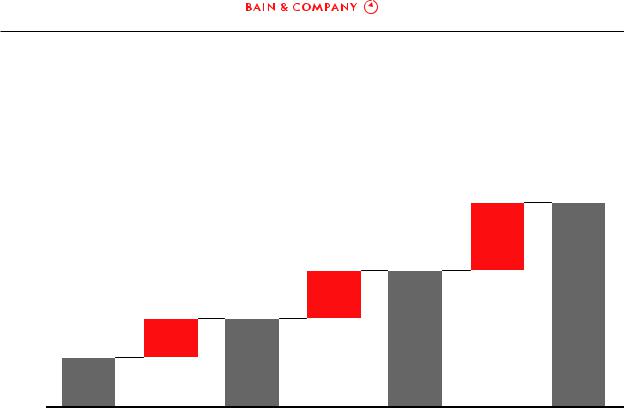
vk.com/id446425943
Global Private Equity Report 2019
Figure 3.1: The rapid growth of financial capital has shaped the global economy—and private . equity—since the 1990s
Total world financial assets $1,000T
|
|
|
|
|
300 |
900 |
800 |
|
|
|
|
|
|
600 |
|
|
207 |
600 |
|
|
|
|
|
|
|
|
|
400 |
172 |
393 |
|
|
|
|
|
|
|
|
|
|
|
221 |
|
|
|
|
|
|
200 |
|
|
|
|
|
|
0 |
|
|
|
|
|
|
1990 |
78% |
2000 |
53% |
2010 |
50% |
2020 |
|
growth |
|
growth |
|
growth |
projected |
Note: All figures are in real 2010 US dollars at 2010 exchange rates
Sources: International Monetary Fund, World Economic Outlook: Slowing Growth, Rising Risks, September 2011; Organisation for Economic Co-operation and Development; national statistics; Bain Macro Trends Group analysis
The flow of capital into the private markets is unprecedented. Partly, that’s because investors simply have more money to put to work than they’ve ever had in the past. Financial engineering, high-speed computing and the loosening of financial regulations have unleashed a superabundance of financial assets over the past 25 years, which has transformed how both the equity and debt markets behave.
Global financial capital increased 53% from 2000 to 2010, reaching some $600 trillion, or 10 times real global GDP. Bain’s Macro Trends Group projects that it is swelling by half again and will reach approximately $900 trillion by the end of 2020 (see Figure 3.1).
This age of superabundance has had both negative and positive effects. The flood of capital led to the housing and buyout booms that imploded so spectacularly during the global financial crisis. Yet the ready liquidity in the aftermath of the crisis also powered the rebound in public and private markets, allowing private equity to recover, regain its momentum and accelerate out of the gloom. Since then, investors hungry for yield have flocked to private equity, enticed by its superior returns relative to other asset classes. Since the start of the current economic cycle in 2009, investors have allocated a staggering $5.8 trillion globally to private equity, and the debt markets have been eager to finance transactions. LPs have also been steadily increasing their overall PE allocations, a sign that they are confident in private capital’s long-term ability to deliver strong performance (see Figure 3.2). Over the past 20 years, private-market capital has grown at more than double the rate of public capital globally, and, at the moment, there’s no slowdown in sight. Indeed, a number of firms are experimenting with ways
74
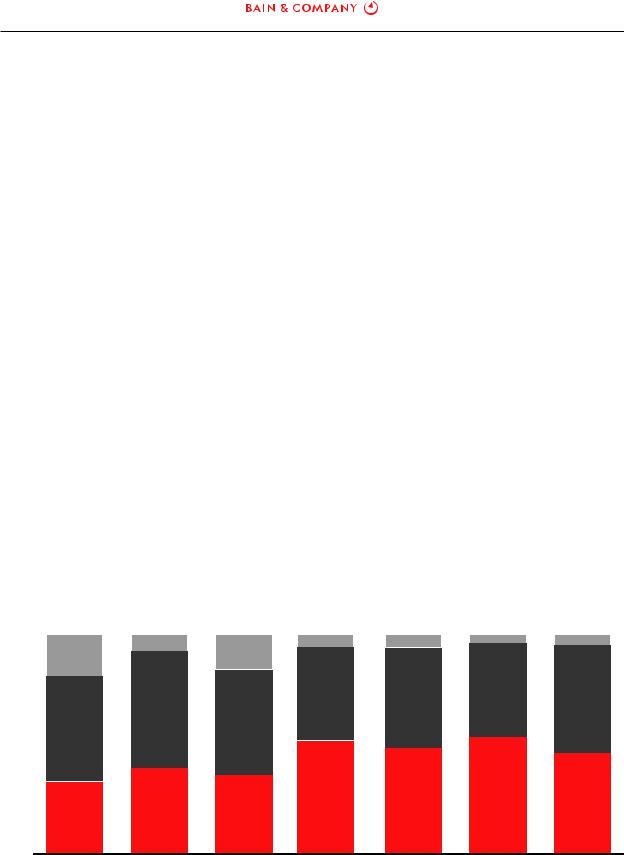
vk.com/id446425943
Global Private Equity Report 2019
to make PE investments available to retail investors. If these innovative new vehicles take off, it could open the floodgates to a massive new investor channel.
As we explained earlier in this report, the unprecedented amount of capital chasing a limited number of assets has driven average buyout purchase price multiples to record highs in recent years. It has also given companies financing choices they’ve never had before. During the late-’90s tech boom, riding the surge in public equities to a blockbuster IPO was the obvious choice for any company looking to finance growth. Today, that’s no longer true. Companies can now tap private equity or institutional capital with relative ease and borrow at historically low rates. That means they can avoid the myriad costs and hassles of going public. Uber, which has ridden almost $21 billion in venture capital to a private valuation of around $72 billion, is the poster child for this new reality. The company has filed to launch a public offering in 2019, but that’s because it has grown to the point that the public markets are now its only option to gain wide-scale liquidity (a real exit) for investors and shareholders.
What’s clear is that the advantages of going public no longer outweigh the considerable disadvantages. First of all, it’s expensive. Initiating a public offering is an exercise in writing checks to investment bankers and lawyers. Being public then adds several million to a company’s cost structure in the form of higher compensation and the many costs associated with financial reporting. For many leadership teams, managing in a fishbowl is also enervating. Relentless scrutiny from Wall Street, quarterly re-
Figure 3.2: Institutional investors are steadily increasing their exposure to private equity
Investors’ stated intentions for long-term PE allocations
Percentage of LPs surveyed
100% |
|
|
|
|
|
|
|
|
Decrease |
|
|
|
|
|
|
|
allocation |
|
|
|
|
|
|
80 |
|
|
|
|
|
|
|
60 |
Maintain |
|
|
|
|
|
|
|
allocation |
|
|
|
|
|
|
40 |
|
|
|
|
|
|
|
20 |
Increase |
|
|
|
|
|
|
|
allocation |
|
|
|
|
|
|
0 |
2012 |
13 |
14 |
15 |
16 |
17 |
18 |
|
|||||||
|
|
|
|
As of year-end |
|
|
|
Source: Preqin surveys |
|
|
|
|
|
|
|
75
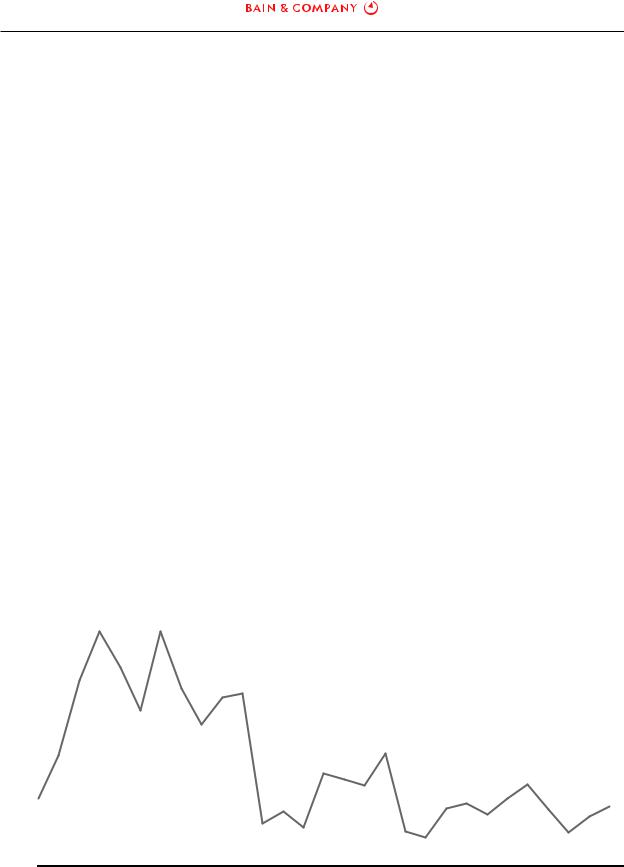
vk.com/id446425943
Global Private Equity Report 2019
porting requirements and the linkage of corporate incentives with short-term performance goals all discourage a long-term perspective on value creation. If the stock price suffers, any number of hostile entities will be ready to swoop in with a massively disruptive takeover bid.
Leaders who have experienced both the public and private arenas rarely equivocate about which they prefer. Michael Dell, who teamed with Silver Lake Partners to take his eponymous PC company private for $24 billion in 2013, put it this way: “Privatization has unleashed the passion of our team members, who have the freedom to focus first on innovating for customers in a way that was not always possible when striving to meet the quarterly demands of Wall Street. As a private company, Dell now has the freedom to take a long-term view.” Dell reemerged as a public company in December to simplify its capital structure. But it did so through a complex cash-and-equity deal that avoided the hassles of an IPO.
Given the choice, more and more companies are choosing to stay or go private. The number of US public companies has declined approximately 45% since its peak 20 years ago, despite a rise in the total number of companies. At the same time, the number of IPOs has plummeted. During the 1990s, the US market averaged 652 public offerings a year. Last year, the total was around one-third of that (see Figure 3.3).
Meanwhile, the pool of companies ripe for take-private transactions is growing. As private multiples have surged and public multiples begin to price in the threat of a recession, a record number of com-
Figure 3.3: The number of US IPOs has dropped substantially since the mid-1990s
Count of US IPOs 1,000
800
600
400
200
0
1990 |
92 |
94 |
96 |
98 |
00 |
02 |
04 |
06 |
08 |
10 |
12 |
14 |
16 |
18 |
Note: Includes only US-based issuers listing on US exchanges
Source: Thomson Reuters
76
